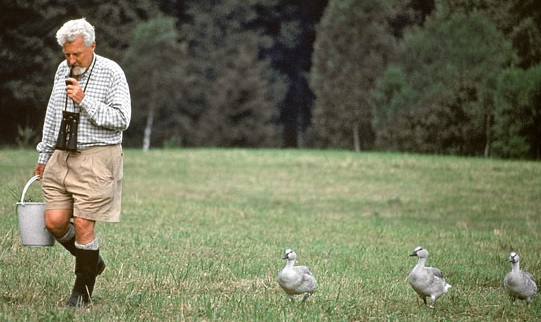Content
- Definition of what it is
- Signs
- What age is it typical for
- Mechanism
- Basic impressions
- Oral
- Territorial-emotional
- Semantic or verbal
- Socio-sexual
- Effects
- Psychological theories and schools
- Imprinting video
Imprinting is a type of memorization and learning, in which the information received is instantly assimilated and stored for life. For the first time this phenomenon in psychology was described by Douglas Spaulding, and the term was introduced by Oscar Heinroth. Translated from English "imprinting" means "imprinting, imprinting."
Definition of what it is
The concept of "imprinting" gained popularity in psychological circles after Konrad Lorenz's experiments with ducks. The researcher found that newly hatched one-day-old ducklings are busy looking for a mother to follow. But it turned out that not just a duck becomes an image for them, but any moving body. So the ducklings mistook the first moving object they saw for their mother. After that, the birds no longer perceived the real duck as a mother figure.

Imprinting in psychology is an experience or a chain of vital experiences of the past that have formed some beliefs in a person (R. Dilts). K. Lorenz believed that imprints are structures in the brain that determine the way of perception and processing of information, response to stimuli.
Italian scientist D. Mainardi considered imprinting as a property not only of animals, but also of higher vertebrates, including humans. However, he noted that in humans this function is presented not analogously to capturing animals, but close to it. D.F. Denisov argued that imprinting in animals is the recognition and choice of a parent, sexual partners, locality, and in humans, the first experience of cultural life.
VC. Vilyunas, R.A. Kiselev, T.A. Titov, noted that imprinting is a method of automatic learning. S.F. Denisova, V.V. Cheshev, L.M. Dmitriev wrote that in the process of imprinting, new semantic and structure values are born. A.G. Ponugaeva in her research indicates that people are more likely to have moral imprinting - the assimilation of behavior that reflects the spiritual values of culture.
Signs
Imprinting in psychology is a process that usually occurs in early childhood. However, there are known cases of later imprinting. The results of this process are irreversible and can hardly be changed further.
Imprinting is characterized by the following features:
- occurs quickly, after a single contact with an object;
- does not require any kind of reinforcement;
- happens in a limited (often crisis) time period;
- is irreversible;
- associated with cultural phenomena;
- affects the rest of his life.
What age is it typical for
Psychologists disagree about the exact age at which the first impression occurs. Researchers of newborns J. Tsaregradskaya, M. Oden, G. Dick-Read believed that there is a period of several hours when a child is open to imprinting. This opinion is criticized by a number of other scientists, as it relies on the knowledge of zoopsychology, thereby identifying humans and animals.
The hypothesis of psychoanalyst J. Bowlby, who studied attachment theory, says that the critical period lasts several hours. In his opinion, this gap continues until the child can move independently and follow a significant adult.
Bowlby distinguishes several phases when a person is subject to imprinting:
- From birth to 3 months. Babies of this age are indistinctly reacting to people in the same ways. They love to listen to human speech, to look at people's faces at close range. A child's positive response is humming, babbling, and a social smile. At first, they apply to everyone in contact with the baby, and later the child reacts to a specific familiar object.
- From 3 to 6 months. During this period, babies become selective in contacts and focus on familiar faces. This way children stop smiling at strangers and just watch them. The child shows humming, crying and other types of non-verbal communication only in the presence of those whom he knows. In addition, from 5 months, children begin to reach out to familiar people, grab them.
- From 6 months to 3 years. From six months on, the child manifests attachment to a particular adult, parent. At the same time, there is a fear of strangers and a fear of separation from the mother, to which children react with loud crying. Also, at this time, the child begins to actively crawl and walk - to master the world around him, observing the adult, not losing sight of him. This is how imprinting on a certain person is expressed.
- From 3 years old until the end of childhood. After 3 years, the influence of the object of imprinting on the child decreases. The parent ceases to be an object of following and gradually becomes a partner in a relationship.
 Consequently, infants and young children are subject to imprinting from the moment they singled out a significant acquaintance of an adult from the whole multitude of people in contact with him. It is this person who becomes the object of following and influences the possible impressions of the child.
Consequently, infants and young children are subject to imprinting from the moment they singled out a significant acquaintance of an adult from the whole multitude of people in contact with him. It is this person who becomes the object of following and influences the possible impressions of the child.
At school and adolescence, children go beyond the boundaries of the family, so there are more people to capture. This is how peers and other adults become role models.
Mechanism
Imprinting in psychology is a transitional mechanism between a conditioned reflex and instinct Researcher G. Horn conducted experiments on animals, as a result of which he found that every species in the nervous system has an innate tendency to impress.
It is activated by visual, olfactory or other sensory stimuli. After the introduction of a certain substance, the brain region responsible for the formation of imprinting was traced on radiographs. It turned out that this area is the medioventral hyperstriatum.
The fewer genetically generated programs, the more the imprinting affects life. In humans, unlike animals, there are practically no built-in genetic programs. Therefore, at the beginning of life, imprinting has a great influence on the subsequent development of the foundations of behavior, perception of reality.
Imprinting in the past was used to demonstrate values and social norms to the younger generation. This usually happened in the process of initiation - initiation rituals, which were accompanied by a stressful state of the participants. Thus, during the initiation, emotional images were broadcast that contained the semantic and cultural norms of a particular group.
As they grow older, the imprints overlap, they begin to influence each other. Under the influence of the accomplished imprinting, a way of perceiving the surrounding world, people, on which a person relies in life, develops.
Basic impressions
Imprinting is not necessarily a negative event that affects a person's life. Imprinting plays a role in the assimilation of socio-cultural, moral, gender norms of behavior. Based on this, different types of imprinting are distinguished in psychology.
Oral
Z. Freud called human birth the first psychological trauma, the first crisis. Therefore, postpartum imprinting is called primary or oral.  The name originated from the way a newborn is fed. Mother's milk and breast are the only source of life for the baby. The mother gives a feeling of comfort and safety.
The name originated from the way a newborn is fed. Mother's milk and breast are the only source of life for the baby. The mother gives a feeling of comfort and safety.
Territorial-emotional
Later, with the development of the territory, the child is separated from the mother and explores the world around him. Throwing toys is seen as a "label" for their personal space. Adults show territorial and emotional imprinting through moving to a new place of residence, buying real estate, land.
Semantic or verbal
Speech or verbal imprinting is the development and understanding of the child's speech. A person's thinking, the ability to communicate, depends on the assimilation of this type of imprinting. An example of verbal imprinting is the study by J. Godefroy. The 114 studied languages contain up to 85 phonemes, 75 of which the infant learns in the first year of life. But only those used in the specific language spoken by the parent are accepted and approved.
Socio-sexual
Social imprinting is formed on the example of basic values, relationships between people. In communication, imprinting can be either positive or negative. It is in contact with another person that information about activities or behavior in society is involuntarily absorbed. Imprinting also goes out of imitation of significant persons. Social impressions affect all aspects of a person's life - abilities, hobbies, choice of partner, type of family communication.
In addition, the imprinting mechanism underlies gender behavior, that is, it has a connection with a person's gender identity. In this regard, during sensitive periods, the child needs communication with a significant adult of the same gender. This makes it possible to form an adequate pattern of behavior according to gender.
Effects
Imprinting in psychology is an important mechanism that can negatively affect the development of the human psyche. If, at the moment of imprinting, the child is separated from the mother or a significant adult figure, then the natural course of mental growth will be disrupted. Subsequently, the baby may develop aggressive tendencies and problems with communication.
It is important for parents to realize that imprinting occurs on a subconscious level and works automatically. Therefore, if possible, it is necessary to reduce the level of stress in the family. Learned patterns of behavior a person reveals after 20-25 years. To reduce their impact on life or change the patterns laid down during imprinting, the help of a psychologist or psychotherapist is needed.
The event causing imprinting can happen in adulthood as well. This happens at a time when the psyche is most vulnerable and sensitive to stimuli. The precedent, which is eventually imprinted, remains with the person for life and is introduced into normal everyday behavior, becomes a part of the person's personality. Therefore, it is important that in times of crisis there is a loving and supportive environment nearby.
Captured events can also create entire systems, accumulating and superimposing on earlier imprinting experiences. A person feels it as hopelessness, incapacity, feels “at a dead end”.
Psychologists in their work with imprints use various techniques and approaches to neutralize the negative impact of impressions. L. Carroll explains this process through a metaphor: “If the water in the hose is constantly under pressure, sprinklers must be installed to control this pressure. Therefore, in order to control or remove something, you need to add something extra. " R. Dilts says that neurolinguistic programming removes the negative effects of imprints.
Psychological theories and schools
Zoopsychologists, ethologists, psychologists and specialists from related scientific trends were engaged in the study of the topic of imprinting. Knowledge of animal imprinting has led to the emergence of several theories of imprinting that have studied this phenomenon in human life.
- Genetic predisposition combined with external stimuli. TO. Lorenz found out that despite the innate predetermination of some functions, for their disclosure they need a stimulus from the external environment. That is, imprinting occurs only when these factors are combined. The scientist believed that imprinting is an evolutionary transition from innate characteristics to learning.
- Protein synthesis and changes in the structure of synapses. WITH. Rose and his colleagues have experimented with chickens. As a result, they found out that proteins are involved in the imprinting process. Their number continues to increase in the brain for several hours after the demonstration of the stimulus, and changes the synaptic structure.
- The structure of neural connections. Biologist R. Simon discovered that imprinting modifies brain tissue. He wrote that imprints (engrams) are a biological manifestation of memory that changes neural tissue in the course of learning.
- Vulnerability of imprints in the nervous system. NS. Silva argued that not all imprints are leading. The work of the nervous system, in his opinion, is to check, weed out unnecessary images, and choose exactly those that will help to survive in a particular society.
- Modeling. R. Dilts, a neurolinguistic psychologist, pointed out that the captured images of parent-child relationships later they are modeled not only in the contact of grown-up children with their children, but also with other people around people.
- Imprinting in the system of condensed experience. WITH. Grof described condensed experience as the experience of a person, assimilated in different periods of his life. In this regard, imprinting is seen as revitalizing a part of a previous experience that evokes positive or negative emotions. They, in turn, affect human behavior, his perception of the world.

Psychologist T. Leary developed the theory of contours. He called the contours the levels (imprints) that consciousness goes through as it develops.
| Circuit | Description |
| Bio-survival | It develops at an early age when the child identifies safe and dangerous places for himself. In the future, the passage of this stage affects confidence, the desire to explore the world, independence. The bio-survival circuit in a hostile situation works as a conditioned reflex. |
| Emotional-motor | Begins from the moment the child begins to walk. This stage reflects the struggle for a place in the family. The imprinting here persists for life and influences behavior in adulthood. The emotional-motor stage determines the level of a person's status, self-confidence, ego strength, superiority or submission in behavior. |
| Mental manipulative | Occurs during the period of speech comprehension. Here imprints arise that affect the amount of assimilated information and the speed of thought processes. In adulthood, the circuit affects the quality of speech, the speed of thinking, and motor dexterity. |
| Sexual-social | Formed in adolescence. Influences the assimilation of morality, moral and spiritual values, forms an attitude towards culture, politics, family. Imprinting in the future determines morality, decency, obedience, parenting style. |
| Pleasure circuit | The stage of realizing the body as an object that brings pleasure. It is expressed in spiritual and physical practices (yoga, hypnosis, shamanism). |
| The contour of ecstasy | Reflects the control of the body by the nervous system. A person experiences ecstatic experiences, understanding the capabilities of his own body and the ability to control it. |
| Neurogenetic | Reflects all stages of human evolution. Responsible for the unusual in a person's life (mystical visions, waking dreams). |
Imprinting in psychology is an unconsciously learned form of behavior. Impressions occur mainly in childhood and affect the rest of your life. Imprinting can also happen in adulthood, so it's worth reducing stress and taking care of your mental health.
Imprinting video
Imprinting. First impression effect:
